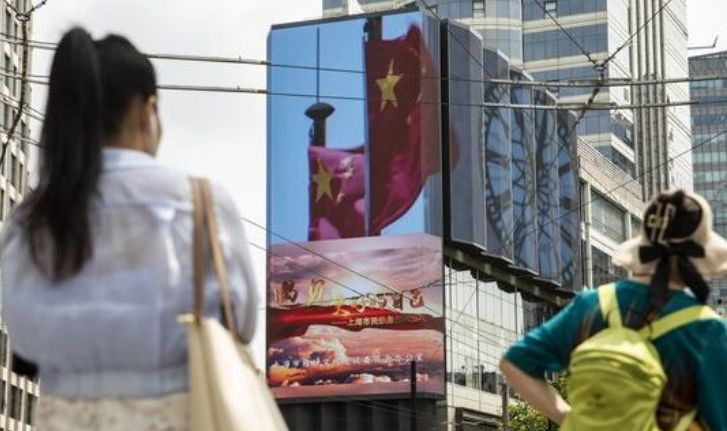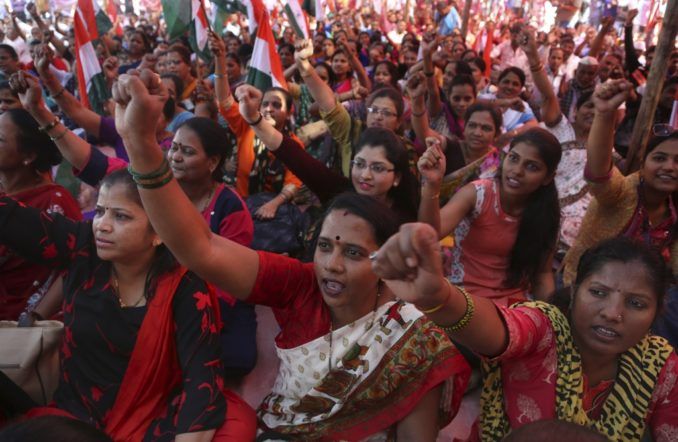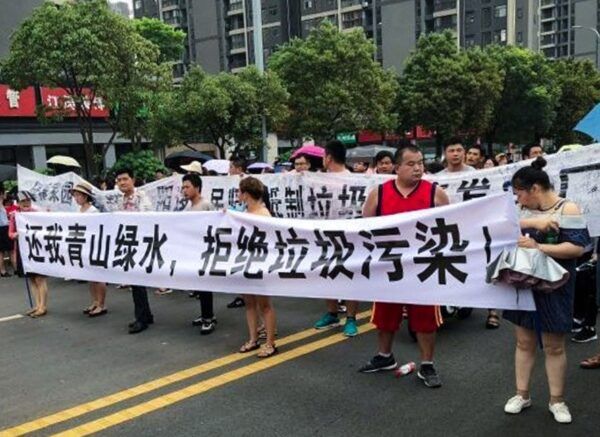Vincent Kolo is a contributor to chinaworker.info.
22 January 2020
Vincent Kolo, chinaworker.info
Confrontation between the two biggest powers set to escalate
The ‘phase one’ trade agreement signed by the US and China on 15 January does not mark the end of their almost two-year trade war. Even as a truce this one is only partial, with two-thirds of the tariffs imposed by both governments over the past 18 months still in place. At best this represents a ceasefire, a shaky one, which in the short-term halts the escalation of their tit-for-tat tariff war, but does not represent any significant de-escalation. Fresh tensions between the two powers could erupt at any moment.
“The mini deal will represent a temporary cease-fire in the US-China trade war, but it’ll never be enough to sustain a long-term truce,” Liao Qun, chief economist at China CITIC Bank International Ltd, told Voice of America. “The US and China will continue to fight their tech war, financial and [even currency] war,” he predicted.
China to spend $200 billion
The main elements of the ‘phase one’ deal are a pledge by the Chinese government to buy an additional $200 billion of US goods and services over the next two years, a partial roll back of tariffs, undertakings that China will open its financial services sector to foreign companies, strengthen its IP (intellectual property) protection and end forced technology transfers which have been a long-term gripe from foreign capitalists.
As an additional sweetener the US government removed China from its list of ‘currency manipulators’, reversing a decision of last August when relations between the two sides hit a particular low. Beijing has agreed it will not devalue the renminbi against the dollar in order to offset US tariffs, and will show greater transparency in its currency policies. For the moment, Beijing is clearly banking on currency stability and a ‘strong renminbi’ as it grapples with a debt crisis and seeks to attract more foreign capital. But the currency pledges included in the ‘phase one’ deal seem unlikely to survive in the longer term.
Mostly, China’s concessions – such as its opening of financial services and tougher IP protection – are not new and they are all steps the Chinese regime itself wants to take. In much the same way as when it joined the World Trade Organisation (WTO) in 2001, Beijing hopes to harness external pressure to reinforce its efforts to force recalcitrant regional governments and state-owned companies to bend the knee to its economic reform policies. The days of the Chinese economy being based mainly on cheap pirate copies are largely over. Given the rapid growth of Chinese tech companies, with world leaders in certain fields (as exemplified by telecom giant Huawei), greater IP protection is a matter of self-interest for the Chinese capitalists and not only to placate foreign capitalists.
A major aim of the Chinese regime, which the trade war makes even more urgent, is to speed up the development of national tech standards and brands largely achieved by copying and adapting the technology from more advanced countries, but legitimised and protected by stronger IP laws. Rather than dismantling its state capitalist model (state intervention and a degree of planning), the US-China conflict pushes Beijing to rely even more heavily on such methods.
“Market principles”
There are many questions about the deal’s viability, especially whether China will be able to honour its $200 billion worth of pledges. This breaks down as an additional $80 billion on US manufactured goods, over $50 billion on energy supplies, $32 billion on farm products and $35 billion on services.
But as its economy slows China’s imports, worth $2 trillion in 2018, are no longer growing. The agreed increases in US imports, if they are achieved, will most likely come through ‘trade diversion’, which is against the rules of the WTO, whereby China for examples buys farm goods from the US at the expense of suppliers in Brazil or New Zealand, and chooses Boeing over Europe’s Airbus to fill its aeroplane orders. This could lead to a rash of trade disputes and retaliation involving countries on the losing end of these arrangements.
Already Chinese officials are stressing that its purchases of additional US imports must be “market based” and not a “one-sided obligation”. It is clear from this that Beijing will attempt to manoeuvre and stall for time, which is a trademark of its economic diplomacy.
There are also doubts that US farmers can actually meet the extra demand from China if it should fulfil its targets under the agreement. The seasonal nature of agricultural production makes the picture even more complicated. As the Chinese economist Andy Xie argues, “This [meeting the target] is unlikely to happen for 2020 as it is already too late to place orders for many commodities, such as soybean. It could happen for 2021. But by then, expect the bickering to restart.” (South China Morning Post, 20 January)
Permanent damage
Clearly, the road ahead will be turbulent. Still, the ‘phase one’ deal may hold until the US presidential elections in November, because both sides will want to avoid a formal collapse due to their respective economic and political vulnerabilities. In Trump’s case, while the substance of the deal invalidates such claims, he intends to exploit this in his re-election bid as a victory over China.
The trade war that began in 2018 has caused permanent and irreversible damage to the world economic order that existed before this. That was characterised by the growing interdependence of the Chinese and the US economies as the central economic relationship of world capitalism. Commentators coined terms like ‘Chimerica’ and the ‘G2’ to sum this up.
That is now a bygone era. It has given way to an increasingly adversarial relationship between imperialist powers, and especially the two giants, the US and China. Even after the signing of the ‘phase one’ deal the average tariffs between the two countries is now 19.3 percent compared to three percent before the trade war began. Tariffs, which are a tax on imports, are now in the words of one financial commentator, “like a [cock]roach motel – they never leave!” Higher tariff levels on a more or less permanent basis are destined to clog up the arteries of global trade.
The WTO reported an increase in global trade of 1.2 percent last year, less than half its 2.6 percent forecast from April 2019. By comparison, global trade grew by an average of 6.9 percent every year from 1990 to 2007, spurring the growth of the global economy. It its most recent report, the International Monetary Fund (IMF) estimates that the accumulative negative impact on the global economy of the US-China dispute between 2018 and the end of 2020 would be 0.8 percent of GDP, but says this could fall to 0.5 percent if the ‘phase one’ truce becomes “durable”. These are significant reductions when global GDP growth was just 2.9 percent last year, according to the IMF, and is forecast to grow 3.3 percent in 2020.
No winners
Trump is proclaiming this a “historic” victory, describing the ‘phase one’ deal as “a big, beautiful monster”. This is classic Trump hyperbole to disguise a very modest and possibly short-lived agreement, the making of which inflicted huge damage on both economies. Most of the concessions from the Chinese regime were on the table even before Trump began to raise tariffs in 2018. Even the size of the signed document, 86 pages, is demonstrative – most trade agreements are much longer. The new USMCA agreement, or “new NAFTA”, between the US, Mexico and Canada, runs to 1,809 pages.
Both Washington and Beijing wanted a face saving agreement allowing them to step back from immediate escalation. Due to Trump’s pig headed poker-style brinkmanship, an escalation was scheduled to kick in on 15 December, with the US extending tariffs to an additional $160 billion of goods, or almost everything it buys from China. Taxing these goods – such as cell phones and laptops, keyboards, computer monitors, headphones and speakers – would have “hurt both sides” as even Trump’s advisors admitted, because consumers would have been affected to a much greater extent than previously. And this, just days before Christmas!
The US side were therefore as anxious as their Chinese counterparts to find a way to disarm this bomb, which would have inflicted pain of a different kind on the US in an election year. It also threatened to be the “straw that broke the camel’s back” for the global economy.
Like two weary boxers, both sides were increasingly desperate for the bell to ring, so they could withdraw to their corners. But it is only a question of when, and over which issues, the fighting resumes. As the past two years demonstrate, neither side is likely to emerge as winner. The weakening of both regimes and capitalist classes is more likely.
Scaled down demands
To achieve the ‘phase one’ deal (few people believe there will be a ‘phase two’) both the US and Chinese regimes have dramatically scaled down their demands. Early last year, Trump insisted there would be a “good deal or no deal”. This proved to be an impossible goal. The ‘phase one’ deal comes nowhere close to the exaggerated claims of Trump and his trade officials that they would settle for nothing less than a complete and verifiable restructuring of China’s economy in line with US demands – to eliminate China’s state capitalist model.
From the Chinese side, the deal is an embarrassing climb down from last year’s strident rhetoric to “fight to the end”. More so because Beijing has for months been churning out anti-US propaganda, blaming it for fomenting the Hong Kong protests, encouraging “separatism” in Xinjiang, and generally interfering in China’s internal affairs, only to reward the offending government with a cheque for $200 billion to be spent on US imports!
The Chinese regime’s presentation of the deal is especially revealing, showing a degree of agitation and nervousness completely at odds with Xi Jinping’s ‘strongman’ image. Xi refused to meet Trump for an official signing ceremony, dumping this responsibility on his Vice Premier Liu He, thus clearly wanting to put some distance between himself and a document that is very likely to be panned as an “unequal treaty” and an American victory by netizens in China. China’s state media has been unusually defensive and restrictive with its coverage of the deal. The Chinese translation of the document was not available until the day of the signing ceremony (the English version was ready weeks earlier) and there was a delay of eight hours after the signing ceremony in Washington before the Chinese government posted any official comment.
The normally bombastic Global Times (a government mouthpiece), which in December insisted the rolling back of all US tariffs was the bottom line for reaching a phase one agreement, ran an editorial after the deal was signed admonishing its readers that debating “about who had lost or gained is shallow.”
“We urge individuals and forces to exercise some restraint in their nit-picking of the agreement and bad-mouthing future trade negotiations,” it wrote.
From the above facts it is clear that Xi’s regime felt enormous pressure to sign the deal and stave off further tariff increases, given a banking sector crisis which is beginning to flash red warning lights, an accelerating slump in investment and consumption, and fear of significant social unrest. The regime fears the effects on mass consciousness if it is seen as weak or as having capitulated to US pressure, especially as this comes after a number of serious political setbacks – not least the mass rejection of the Chinese regime in Hong Kong and Taiwan.
The process of de-globalisation and especially the de-coupling of the US and Chinese economies, an unpicking and rerouting of supply chains, will not be arrested by this agreement. As the Economist magazine noted in an editorial: “A partial dismantling of their bonds is under way. In the 2020s the world will discover just how far this decoupling will go…” (The superpower split: Don’t be fooled by the trade deal between America and China, The Economist, January 2, 2020).
While it’s not possible to “put the omelette back in the egg” in terms of a complete reversal of global economic integration, it’s clear the de-coupling of the US and Chinese economies, and the wider process of de-globalisation, are already underway, with sharp falls in investment and corporate takeovers, falling trade (the US is now China’s third largest trade partner from number two in 2018) and a significant exodus from China to Vietnam, India, Southeast Asia and Mexico, of companies that export to the US market. This process – a redrawing of global production chains – could still accelerate despite the ‘phase one’ deal.
Infinity war
The conflict between the two biggest economies and imperialist powers is an ‘infinity war’ which will continue with inevitable ebbs and flows as the two regimes spar for global dominance. Even as the US and China signed the agreement in the White House, US government departments were preparing new measures against Chinese telecom giant Huawei, which has been in the cross hairs of the US military and national security establishment in particular because of its dominant role in 5G technology, the next generation of wireless networks.
The US is stepping up pressure on governments in the UK and Germany to ban Huawei from their 5G infrastructure, while expanding the list of Chinese companies – already over 100 – on a government blacklist that cuts off their access to US tech components such as semi-conductors. The contradictions of this, at the same time as the US insists that China spend $80 billion more on manufactured goods, a big part of which would need to be tech products, are glaring.
Meanwhile, in Vancouver, a three way struggle between China, Canada and the US is reaching a critical phase as Huawei’s billionaire heiress and Chief Financial Officer, Meng Wanzhou, goes on trial this week over fraud and sanctions-busting charges that could see her extradited to the US to face a possible 30-year jail sentence. The judicial kidnapping of Meng, which led the Chinese dictatorship to reply in kind with the imprisonment of two Canadian citizens, is an important battleground in the tech war between US and Chinese imperialism.
Further trouble is brewing in the US-China relationship over Taiwan, Hong Kong and Xinjiang, the Iran crisis, heightened military activity by both sides in the South China Sea, and the growing trend towards financial protectionism (banning foreign investment on ‘national security’ grounds). A pause in the US-China tariff war may also open the way for new trade conflicts pitting the Trump administration against Europe, Japan and others. In two rounds, in 2018 and again last year, Trump has slapped tariffs on aluminium and steel from the EU, and $7.5 billion of other products in connection with a WTO ruling in favour of the US over European subsidies to aircraft maker Airbus. Trump is now also threatening tariffs against Italy and Britain over plans to tax digital companies such as Google and Facebook. The French government caved in to Trump’s threats over a similar tax proposal.
The EU and other trading powers, while relieved the US and China appear to be stepping back from further escalation, are crying foul that the new agreement amounts to “managed trade” in violation of the principles of “free trade”.
This is another nail in the coffin of the WTO, which has already been paralysed by Trump’s decision last year to block the appointment of judges for the WTO’s dispute settlements system. This arbitration system, which has been credited with holding trade conflicts in check, is now broken. Under Trump, the US government has decisively abandoned multilateralism in favour of a bilateral strategy to reach trade agreements on a state-to-state basis. As the biggest economy this gives the US an advantage, until new crises and shocks change the balance of power, while the wider impact is a more fragmented and unstable global economy.
The ‘phase one’ trade agreement is a deal between representatives of a capitalist system in turmoil and decline. Neither side is likely to draw any lasting gains and neither will we. The interests of workers and the poor can only be met by building a mass socialist alternative in the US, China and globally, to sweep away this system and to build a society based on democratic planning and international solidarity.




